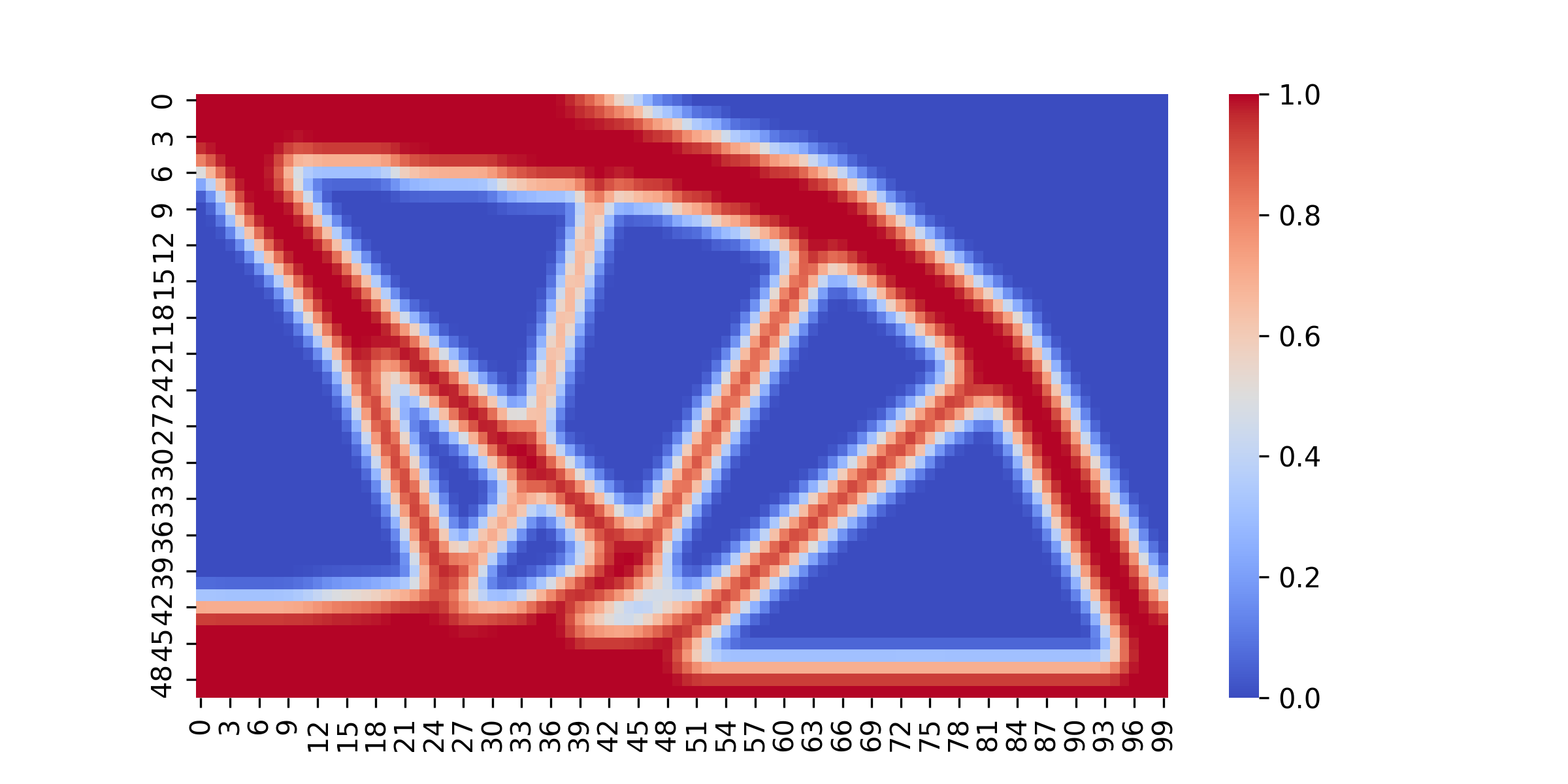Beams2D#

Version |
0 |
Design space |
|
Objectives |
c: ↓ |
Conditions |
volfrac: 0.35 rmin: 2.0 forcedist: 0.0 overhang_constraint: False |
Dataset |
|
Import |
|
Beam 2D topology optimization problem.
Problem Description#
Beams2D is a structural topology optimization (TO) problem that optimizes a 2D Messerschmitt-Bölkow-Blohm (MBB) beam under bending. The beam is symmetric about the central vertical axis, with a force applied at the top; only the right half is modeled in our case. Problems are formulated using density-based TO, drawing from an existing Python implementation.
Motivation#
The optimization of beam cross-sections is one of a fundamental problem in engineering, aiming to maximize the structural stiffness under some applied force. This objective is usually formulated as minimizing the compliance, which is the inverse of stiffness. In particular, TO frames the problem as one of optimal material distribution, defining a grid of elements for which the material densities must be determined on a scale from 0 to 1, where 1 represents the presence of material. After applying the beam loads and other boundary conditions, designs are typically optimized using a gradient-based approach with the help of the finite element method (FEM). While this is one of the simplest TO applications, it is still a computationally expensive process requiring many iterations, opening the door for faster approximation methods such as generative inverse design. One of the most common beam types in TO is the Messerschmitt-Bölkow-Blohm (MBB) beam, which is supported at the bottom-right and bottom-left corners, with a downward force applied on the top-center. Given this symmetric configuration, one half of the design may be optimized while representing the entire structure. We implement the MBB beam in ENGIBENCH for the most accessible comparison to previous works in this domain.
Design Space#
This problem simulates the right half-section of a MBB beam under bending. This half-beam is
subjected to a force at its top-left corner (corresponding to the top-center of the entire design) which
may also be shifted to the right to simulate different loading conditions. A roller support at the
bottom-right corner prevents vertical movement, and a symmetric boundary condition is enforced on
the left edge. The design space is an array of solid densities in [0., 1.] with a default size of
(100, 50) used by default, where nelx = 100 and nely = 50. Internally, this is represented as
a flattened (5000,) array. Alternative shapes include (50, 25) for faster computation and (200, 100)
for higher-resolution results. Corresponding datasets for these three resolutions are provided.
Objectives#
The goal is to optimize the distribution of solid material to minimize compliance (equivalently, maximize stiffness) while satisfying constraints on material usage and minimum feature size. Compliance is calculated as the sum of strain energy over the structure.
The objectives are defined and indexed as follows:
c: Compliance to minimize.
Conditions#
The following input parameters define the problem conditions:
volfrac: Desired volume fraction of solid material.rmin: Minimum feature length of beam members.forcedist: Fractional distance of the downward force from the top-left (default) to the top-right corner.overhang_constraint: Boolean flag to enable a 45-degree overhang constraint for manufacturability.
Simulator#
Our simulation code is based on a Python adaptation of the popular 88-line topology optimization
code. It uses the more versatile density filtering approach in combination with a standard
Optimality Criteria (OC) optimization method. Two primary sensitivity matrices, one with respect
to compliance (dc) and the other with respect to volume fraction (dv), are continuously updated
and used to calculate a given design’s compliance value. We have also ensured that during the
required Lagrange multiplier search within OC, the inner optimization loop terminates if the absolute
difference upper and lower bounds diminishes to a value smaller than machine precision. This
prevents the code from becoming stuck at this point, which we observed in some warm-starting
instances with noisy initial designs.
Compliance c is calculated using:
c = ((Emin + xPrint**penal * (Emax - Emin)) * ce).sum()
where xPrint is the current true density field, penal is the penalization factor (e.g., 3.0),
and ce is the element-wise strain energy density.
Dataset#
This problem offers multiple datasets for various sizes of nelx and nely. Each dataset includes
columns for the optimal design, all conditions listed above, and the corresponding objective values.
For advanced usage, we also provide a column containing the optimization history. The datasets have
been generated by sampling conditions over a structured grid for various problem sizes.
Three datasets are available on the Hugging Face Datasets Hub.
They correspond to resolutions of \(50 \times 25\), \(100 \times 50\) (default), and \(200 \times 100\).
v0#
Fields#
Each dataset contains:
Optimized beam structures,
The corresponding condition parameters,
Objective values (compliance),
Full optimization histories (for advanced use).
Creation Method#
Datasets were generated by uniformly sampling the condition space. The resolutions used are:
(50, 25)(100, 50)(200, 100)
A more comprehensive description of the creation method can be found in the README.
Citation#
If you use this problem in your research, please cite the following paper:
@article{andreassen2011efficient,
title={Efficient topology optimization in MATLAB using 88 lines of code},
author={Andreassen, Erik and Clausen, Anders and Schevenels, Mattias and Lazarov, Boyan S and Sigmund, Ole},
journal={Structural and Multidisciplinary Optimization},
volume={43},
number={1},
pages={1--16},
year={2011},
publisher={Springer}
}
Lead#
Arthur Drake @arthurdrake1
